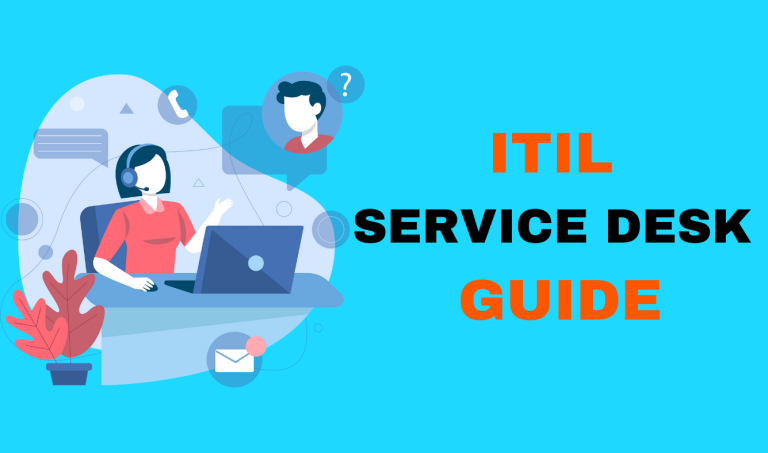The IT Infrastructure Library (ITIL) is a globally recognised framework for IT service management (ITSM) that provides best practices for delivering high-quality IT services. One of the core components of ITIL is the ITIL Service Desk.
This blog post by Creative Networks will delve into the various aspects of the ITIL Service Desk, including what it is, who needs it, why it is useful, and how it operates.

What is ITIL?
The Information Technology Infrastructure Library (ITIL) is a set of best practices designed to help organisations provide efficient and effective IT services. Developed by the Central Computer and Telecommunications Agency (CCTA) in the UK, and now managed by AXELOS Ltd, ITIL offers a systematic approach to ITSM, focusing on aligning IT services with the needs of the business.
Key Components of ITIL:
- Service Strategy: Defines the strategy for IT services, ensuring they align with business goals.
- Service Design: Focuses on the design of IT services, including architectures, processes, policies, and documentation.
- Service Transition: Manages changes to IT services, ensuring that they are deployed with minimal risk and impact.
- Service Operation: Oversees the day-to-day management of IT services.
- Continual Service Improvement: Seeks to improve IT services and processes continuously.
What is the ITIL Service Desk?
An ITIL Service Desk is a critical component of IT service management that serves as the primary point of contact between users and the IT organisation. It handles incidents and service requests, providing a single channel for users to communicate their IT-related issues or inquiries.
Functions of the ITIL Service Desk
The ITIL Service Desk plays a pivotal role in ensuring smooth IT operations and user satisfaction.
It encompasses several key functions:
Incident Management
- Objective: Restore normal service operations as quickly as possible to minimize the impact on business operations.
- Activities: Logging incidents, categorizing and prioritizing them, diagnosing and resolving incidents, and escalating complex issues to higher-level support if necessary.
- Outcome: Ensures minimal downtime and disruption to business activities, enhancing overall productivity.
Service Request Management
- Objective: Efficiently handle user requests for information, advice, or access to IT services.
- Activities: Managing a wide range of service requests such as password resets, software installations, and access to applications.
- Outcome: Provides users with timely responses and resolutions to their requests, improving user satisfaction and operational efficiency.
Communication
- Objective: Maintain clear and effective communication with users regarding their issues’ status and progress.
- Activities: Keeping users informed about incident statuses, expected resolution times, and any updates or changes.
- Outcome: Builds user trust and ensures transparency, reducing user frustration and confusion during service disruptions.
Change Management
- Objective: Manage changes in the IT environment with minimal disruption to services.
- Activities: Coordinating with other ITIL processes to manage and communicate changes, ensuring that changes are logged, assessed, approved, and implemented with minimal risk.
- Outcome: Reduces the risk of service interruptions and ensures that changes are implemented smoothly and effectively.
Problem Management
- Objective: Identify and resolve the root causes of incidents to prevent recurrence.
- Activities: Performing root cause analysis, developing workarounds and permanent solutions, and communicating findings to relevant stakeholders.
- Outcome: Reduces the frequency and impact of incidents, improving the overall stability and reliability of IT services.
Who Needs ITIL?
ITIL is beneficial for organisations of all sizes and industries that rely on IT services to support their business operations.
This includes:
- Large Enterprises: With complex IT infrastructures, large enterprises benefit from ITIL’s structured approach to managing and delivering IT services.
- Small and Medium-sized Businesses (SMBs): SMBs can use ITIL to improve their IT service management practices and ensure they deliver high-quality IT services.
- Public Sector Organisations: Government and public sector organisations can enhance their IT service delivery and efficiency using ITIL.
- IT Service Providers: Companies that provide IT services to other organisations can adopt ITIL to standardize their service delivery and improve customer satisfaction.

Why ITIL is Useful
ITIL provides numerous benefits to organisations by improving their IT service management practices.
Here’s why ITIL is useful:
Alignment with Business Goals
ITIL helps organisations align their IT services with their business objectives, ensuring that IT supports the overall business strategy. This alignment enhances the value of IT services and ensures that they contribute to the achievement of business goals.
Cost Reduction
By optimising IT service management processes, ITIL helps organisations reduce costs. This includes minimising downtime, improving resource utilization, and reducing the need for expensive emergency fixes. ITIL’s focus on continuous improvement also helps organisations identify and eliminate inefficiencies.
Enhanced Customer Satisfaction
ITIL’s best practices ensure that IT services are delivered consistently and reliably, leading to higher customer satisfaction. By providing a structured approach to incident and request management, ITIL helps organisations respond to user issues more quickly and effectively.
Improved Service Quality
ITIL emphasizes the importance of service quality and continuous improvement. By following ITIL’s best practices, organisations can ensure that their IT services meet high standards and continuously improve over time. This leads to more reliable and efficient IT service delivery.
Better Risk Management
ITIL helps organisations manage risks associated with IT service delivery. By implementing standardized processes for change management and incident response, ITIL reduces the likelihood of service disruptions and helps organisations respond more effectively when issues arise.
ITIL Service Desk Stages
Service Strategy
Service strategy involves understanding customer needs and the market. It advocates for a long-term, market-driven approach to IT support.
Key processes in this stage include:
- Service Portfolio Management: Managing the services that make up the service portfolio.
- Demand Management: Understanding and influencing customer demand for services.
- Financial Management: Managing the financial aspects of IT services.
Service Design
Service design focuses on developing IT services that meet customer needs.
It involves:
- Service Level Management: Ensuring that IT services meet agreed service levels.
- Availability Management: Ensuring that IT services are available as needed.
- Capacity Management: Ensuring that IT services have sufficient capacity to meet demand.
- IT Service Continuity Management: Ensuring that IT services can be restored quickly in case of disruption.
Service Transition
Service transition manages the introduction of new or changed services into the live environment.
It includes:
- Change Management: Controlling the lifecycle of all changes.
- Release and Deployment Management: Managing the release and deployment of services.
- Configuration Management: Maintaining information about the configuration of services.
Service Operation
Service operation ensures that IT services are delivered effectively and efficiently.
It includes:
- Incident Management: Restoring normal service operation as quickly as possible.
- Problem Management: Identifying and resolving the root causes of incidents.
- Request Fulfillment: Managing service requests from users.
Continual Service Improvement (CSI)
CSI focuses on improving IT services and processes over time.
It involves:
- Service Review: Regularly reviewing services to identify areas for improvement.
- Process Evaluation: Evaluating processes to ensure they are efficient and effective.
- Improvement Initiatives: Implementing initiatives to improve services and processes.
Types of Service Desk in ITIL
A service desk can be implemented in various ways, each with its own set of potential applications and restrictions:
Centralised Service Desk
A centralised service desk serves as a single point of contact for all queries and issues.
Benefits include:
- Quick Ticket Resolution: Efficient handling of support tickets.
- Simplified Ticket Management: Easy management of tickets, regardless of volume.
- Consolidation: Centralized control of service desks.
Local Service Desk
A local service desk is situated on or near a business’s premises.
It is suitable for:
- Small to Medium-sized Businesses: Handling a limited number of support tickets.
- On-site Resolution: Resolving challenges at the business location.
Virtual Service Desk
A virtual service desk relies on internet connectivity and can be accessed from any location.
Advantages include:
- Remote Access: Ability to resolve tickets from anywhere.
- Geographic Organisation: Efficient ticket organisation based on location.
- Agent Performance Tracking: Effective monitoring of agent performance.
ITIL is a comprehensive framework that provides best practices for IT service management. By adopting ITIL, organisations can enhance their IT service delivery, reduce costs, improve customer satisfaction, and better align IT with business goals. The ITIL Service Desk plays a crucial role in this framework, serving as the primary point of contact between users and the IT organisation.
Contact Creative Networks Today
Ready to enhance your IT service management with an efficient and reliable ITIL Service Desk? Creative Networks offers comprehensive ITIL Service Desk solutions tailored to meet your business needs.
Contact us today to learn more about how our ITIL Service Desk can improve your IT operations and support your business objectives.
Visit Creative Networks for more information and to get started!




